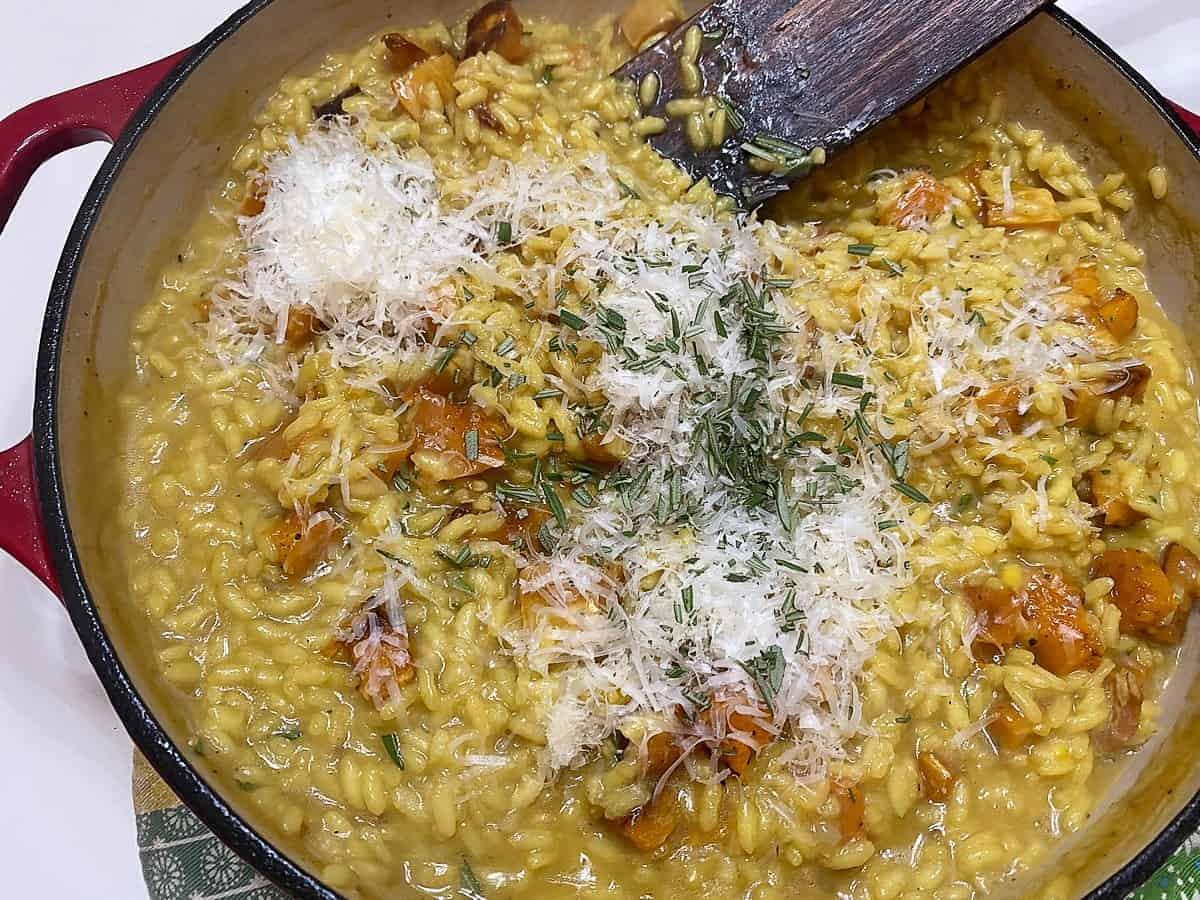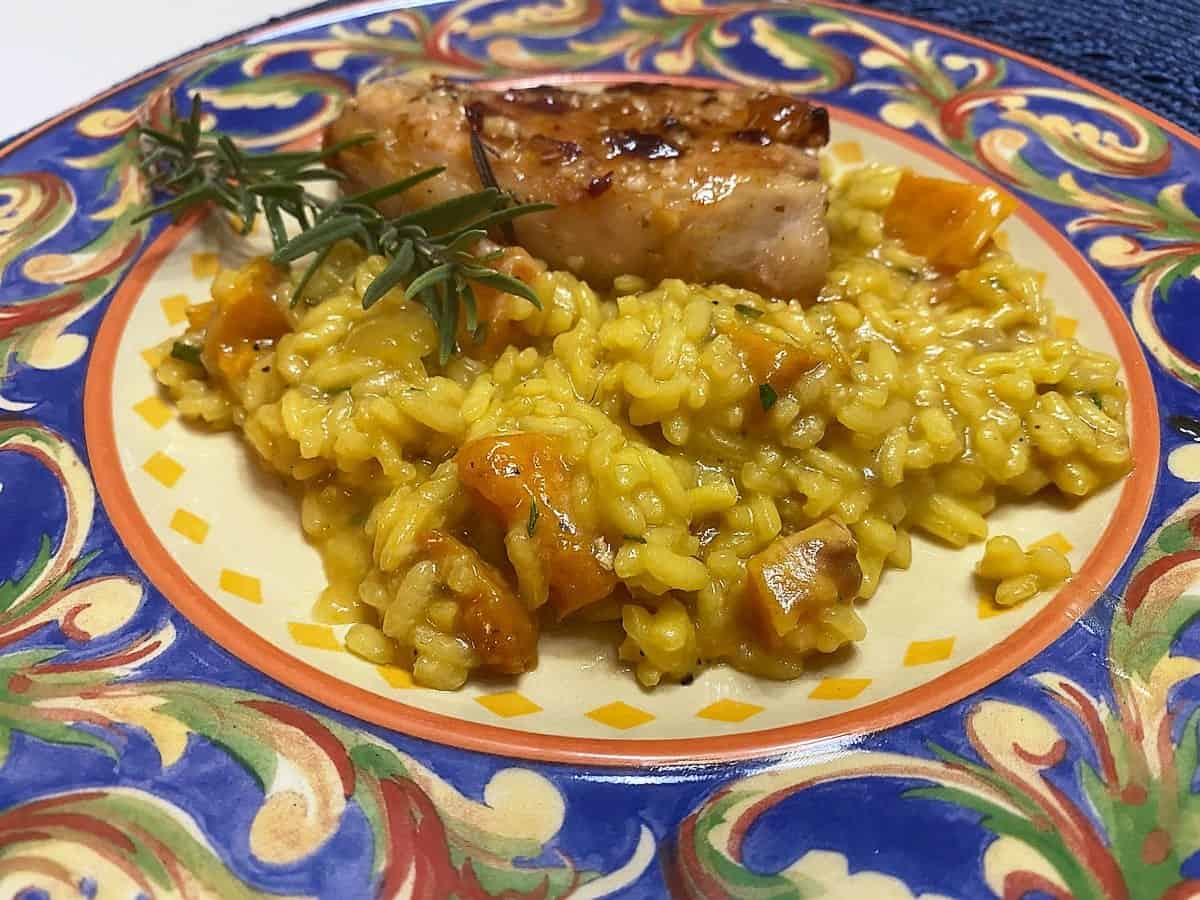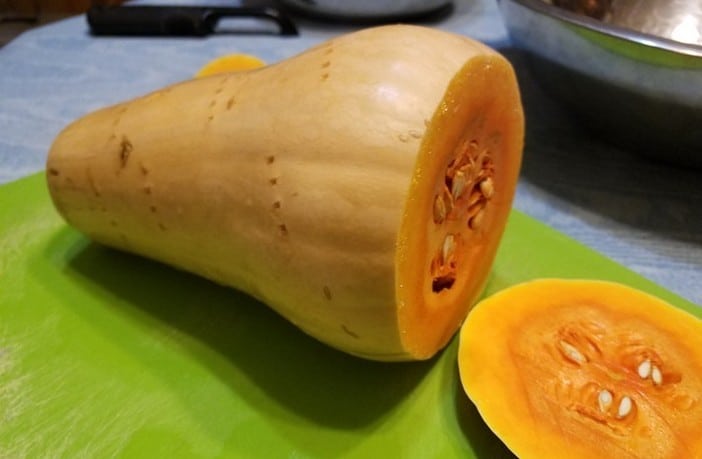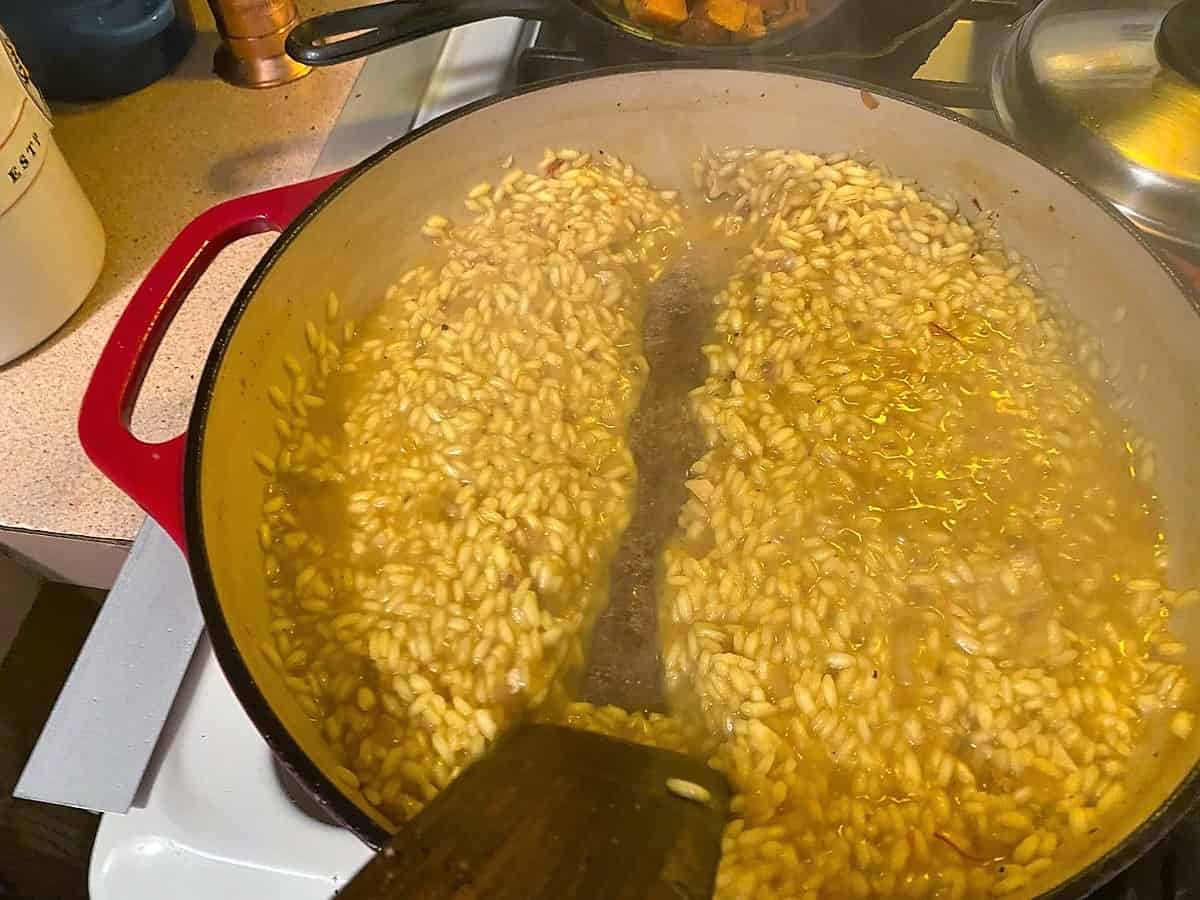Butternut Squash Risotto with Saffron

This post may contain affiliate links, which means I may receive a commission if you make a purchase using these links. As an Amazon Associate, and a King Arthur Baking affiliate, I earn from qualifying purchases.
This past year I have been experimenting with risotto recipes, and this Butternut Squash Risotto with Saffron is a new favorite. Creamy risotto with tender roasted butternut squash, flavored with the subtle essence of savory saffron. A perfect side dish for autumn, served with your favorite chicken or pork recipes.

(Post modified on 10/27/23.)
As a recipe blogger, I enjoy trying new foods and ingredients. Sometimes, my recipes turn out delicious. Other times, not so much. Just ask my husband about the disasters in my kitchen. Butternut Squash is one of the “new” foods on my list, a vegetable I had never even tasted until a few years ago. So far, I’ve added it to roasted vegetables and ravioli, made a delicious Butternut Squash Bisque with Bacon, and now risotto. Overall, my experience with this orange-colored winter squash have been positive.

Butternut Squash is a wonderful vegetable to cook with during the fall season, and it’s quite versatile. Cut it up to use with roasted vegetables, make soup with it, or add it to your favorite stir-fry, pasta, or rice dishes. Plus, it’s loaded with nutrition and is a great source of fiber. Full of beta-carotene and alpha-carotene, it’s good for your eye health, and for your immunity. If that’s not enough, it also helps to manage blood sugar, and blood pressure.
I admit that the addition of saffron to this recipe is a splurge item, but well worth it if your budget allows for this exotic spice.
What is Saffron and Why is it so Expensive?

Saffron comes from the stigma of the crocus flower, which has three threads per flower. This translates into approximately 1.5 million flowers to make 10 kg of saffron. It’s also hand-picked, which adds to the cost of labor.
Saffron is said to be worth more than gold. But what makes it so special? A little bit of Saffron will turn your dishes a deep yellow color. But it will also add complexity to the flavor of your recipes. It has a flavor profile that is delicate, earthy, floral, and sweet like honey, and may have a metallic bitterness to it. Saffron is highly nutritious, filled with minerals and antioxidants that help to prevent illnesses and boost immunity. See this Article on the Health Benefits of Saffron.
Yes, saffron is one of the most expensive spices you can buy. But the good news is that a little goes a very long way. This recipe, for instance, only uses 1/2 teaspoon, which is about 6-10 threads. I purchased my container of Saffron on Amazon after reading many good reviews for it.
Use saffron in rice, pasta, and chicken recipes, or in cakes and breads. You may even use it in milk drinks or in tea. I look forward to experimenting with this exotic spice in the months ahead.
However, if the addition of saffron doesn’t fit your budget, there is an easy substitute that is almost as good, and is certainly easier on the pocketbook. Inexpensive, even, and uses ingredients available in most kitchens. Turmeric and Paprika.
Use 1/2 teaspoon turmeric and 1 teaspoon paprika to equal 1/2 teaspoon of Saffron.
More Squash Recipes to Enjoy
- Butternut Squash Bisque with Bacon
- Braided Squash Bread
- Cheesy Squash Bake
- Tagliolini with Vegetables and Sausage
Ingredients for Butternut Squash Risotto with Saffron
(See the full recipe at the bottom of this post.)
Roasted Butternut Squash
- butternut squash, small 1/2″ cubes
- olive oil
- seasoned salt
- freshly ground black pepper
Risotto
- chicken bouillon cubes + water
- butter
- olive oil
- sweet onion, minced
- garlic, minced
- Arborio rice
- dry white wine
- saffron threads
- kosher salt
- freshly ground black pepper
- parmesan cheese, freshly grated
- rosemary for garnish
TIPS ON PEELING AND CUTTING A BUTTERNUT SQUASH
Much like a sweet potato or pumpkin, the outer covering on a butternut squash is rather thick and can be somewhat hard to cut through. Here are a few tips to help you with this task.

Place the squash on a large cutting board and with a sharp chef’s knife or Santoku knife, trim both ends of the squash. Slice through the squash carefully, using as little pressure as possible.
Stand the squash on one end, and using a vegetable peeler, run the peeler down the length of the squash to remove the skin.
I found the easiest way to do this was to peel around the top half of the squash and then turn the squash and peel the remaining half, rotating as you go. I also used a Y-shaped vegetable peeler.
Now, carefully cut the squash in half at the neck.

Slice the neck half into cubes or large rounds, whichever you prefer. To slice into the body portion of the squash, you’ll want to cut it in half lengthwise. Then scrape out the seeds with a spoon or cut it out with a knife after you’ve made slices in it.
This recipe calls for small cubes, so I sliced the squash and from there cubed it into 1/2 – 1″ cubes.
Instructions for Making this Recipe

Preheat oven to 375 degrees. Gather your ingredients so that you have everything close at hand on the counter or table. Line a baking sheet with parchment paper or aluminum foil. Spray with baking spray.
Prepare the Ingredients
Using a peeling knife, a chef’s knife and cutting board, peel and slice the butternut squash into small cubes. Place the cubed butternut squash in a bowl and drizzle olive oil over it. Sprinkle with seasoned salt and freshly ground black pepper. Stir until the squash is covered in oil. Spread squash out on the prepared baking sheet. Bake for 25-35 minutes, until fork tender.
In a medium saucepan, bring to a boil the water and bouillon cubes (or chicken broth), and then reduce to a simmer, stirring to combine.
You will keep the broth on simmer for the entire process of making this dish.
While the butternut squash bakes, mince the sweet onion and garlic with a knife and cutting board.

Soak the saffron threads (6-10 threads) in 1/4 cup warm water for about 10 minutes.
For best results when using saffron, either crush the threads with a mortar and pestle (if using in liquids) or soak threads in warm liquid (water, broth, wine, milk) for at least 10 minutes to bring out the “bloom” in color and taste.
Grate the fresh parmesan and place in a bowl until ready to use.
Make the Risotto

The Soffritto
In a large skillet or saute pan, melt butter and olive oil over medium-low heat. Add the minced onion and cook until tender, about 1-2 minutes, stirring often. Stir in the garlic and cook for about a minute more, being careful not to let it brown.
Italian cooks refer to this base step of sauteing onion and garlic to a dish as soffritto, the initial steps to give a dish its greatest flavor, upon which you build.
Add the Rice

Once the onion and garlic are tender, add the Arborio rice and cook on medium-low, stirring constantly until glossy and coated with oil, about 2 minutes. Make sure to stir to the edges of your pan to include every grain of rice.
When making Risotto, I like to use my wooden spurtle, which has a flat edge and reaches easily into the “corners” of a pan.

Now add the white wine and saffron mixture to the rice. Stir until the alcohol is absorbed, about 1 minute.
When choosing a wine to use for this recipe, go with a dry white wine, and always use a wine that you enjoy drinking. If you are opposed to cooking with wine, simply omit this step, although it does give the dish wonderful flavor.
Begin ladling in the chicken broth, about a cup at a time. Stir frequently until it is absorbed.
Frequent stirring dissolves the starch in the rice and produces the creaminess in Risotto. Once the broth is added to the rice, begin stirring, scraping the spurtle along the bottom and sides of the pan until the liquid has absorbed. Then repeat.

Continue adding broth in this fashion until the rice has cooked to al dente and is creamy, approximately 20-25 minutes. Add broth, stir, cook, stir, and repeat. When you get close to al dente, you’ll want to reduce the amount of broth you add each time.
I like to start tasting the rice after 20 minutes to see how it is doing. For al dente, you want the rice to be tender, but firm to the bite. When it gets close to this stage, you will gradually reduce the amount of broth you add. Your finished risotto should be slightly moist, but not runny. You may or may not use up all the chicken broth.
Final Step – Mantecare

For the finishing touch, add the remaining butter and freshly grated Parmesan. Swirl vigorously to combine. Taste and add more salt or black pepper, if desired.
If the risotto is too thick, you may thin it with a little bit of whole milk. I have never had to do this, but please know that it is okay to do if you need to!

Now stir in the roasted butternut squash and remove the pan from the heat.

Transfer to a serving bowl and serve warm. Garnish with more freshly grated Parmesan and fresh rosemary, if desired.
See Risotto Recipes Here. View Side Dishes Here. Browse Italian Dinner Ideas Here.
Butternut Squash Risotto with Saffron
Ingredients
- 2 pounds butternut squash cut into small 1/2" cubes
- 2 tablespoons extra virgin olive oil
- 1 teaspoon seasoned salt
- 1/2 teaspoon freshly ground black pepper
Risotto
- 4 cubes chicken bouillon cubes + 6 cups water or chicken stock
- 4 tablespoons butter divided
- 2 tablespoons extra-virgin olive oil
- 1/2 cup sweet onion minced
- 2 cloves garlic minced
- 1 1/2 cups Arborio rice
- 1/2 cup dry white wine
- 1/2 teaspoon saffron threads 6-10 threads
- 1/2 teaspoon kosher salt
- 1/2 teaspoon freshly ground black pepper
- 1 cup freshly grated parmesan cheese
- 2 teaspoons fresh rosemary chopped, for garnish
Instructions
- Preheat oven to 375 degrees. Gather your ingredients so that you have everything close at hand on the counter or table. Line a baking sheet with parchment paper or aluminum foil. Spray with baking spray.
Prepare the Ingredients
- Using a peeling knife, a santoku knife and cutting board, peel and slice the butternut squash. Place the cubed butternut squash in a bowl and drizzle olive oil over it. Sprinkle with seasoned salt and freshly ground black pepper. Stir until the squash is covered in oil. Spread squash out on the prepared baking sheet. Bake for 25-30 minutes, until fork tender.
- In a medium saucepan, bring to a boil the water and bouillon cubes (or chicken broth), and then reduce to a simmer, stirring to combine. - You will keep the broth on simmer for the entire process of making this dish.
- While the butternut squash bakes, mince the sweet onion and garlic with a knife and cutting board.
- Soak the saffron threads (6-10 threads) in 1/4 cup warm water for about 10 minutes.
- Grate the fresh parmesan and place in a bowl until ready to use.
Make the Risotto
- The Soffritto - In a large skillet or saute pan, melt butter and olive oil over medium-low heat. Add the minced onion and cook until tender, about 1-2 minutes, stirring often. Add to this the garlic and cook for about a minute more, being careful not to let it brown.
Add the Rice
- Once the onion and garlic are tender, add the Arborio rice and cook on medium-low, stirring constantly until glossy and coated with oil, about 2 minutes. Make sure to stir to the edges of your pan to include every grain of rice.
- Now add the white wine and saffron mixture to the rice. Stir until the alcohol is absorbed, about 1 minute.
- Begin ladling in the chicken broth, about a cup at a time. Stir frequently until it is absorbed. - Once the broth is added to the rice, begin stirring, scraping the spurtle along the bottom and sides of the pan until the liquid has absorbed. Then repeat.
- Continue adding broth in this fashion until the rice has cooked to al dente and is creamy, approximately 20-25 minutes. Add broth, stir, cook, stir, and repeat. When you get close to al dente, you’ll want to reduce the amount of broth you add each time.
- (I like to start tasting the rice after 20 minutes to see how it is doing. For al dente, you want the rice to be tender, but firm to the bite. When it gets close to this stage, you will gradually reduce the amount of broth you add. Your finished risotto should be slightly moist, but not runny. You may or may not use up all the chicken broth.)
Final Step - Mantecare
- For the finishing touch, add the remaining butter and freshly grated Parmesan. Swirl vigorously to combine.
- Once you’ve achieved al dente, stir in the roasted butternut squash and remove the pan from the heat. Taste and add more kosher salt or freshly ground black pepper, if desired.
- (If the risotto is too thick, you may thin it with a little bit of whole milk. I have never had to do this, but please know that it is okay to do if you need to!)
- Transfer to a serving bowl and serve warm. Garnish with more freshly grated Parmesan and fresh rosemary, if desired. Serves 4-6.
Notes
Nutrition



